Bioadsorption of Terbium(III) by Spores of Bacillus subtilis
Abstract
:1. Introduction
2. Materials and Methods
2.1. Bacterial Strains and the Preparation of Cells and Spores
2.2. Adsorption of Tb(III) by B. subtilis
2.3. Adsorption of Rare Earth Ions in Wastewater
2.4. Characterization of B. subtilis Spores before and after Adsorption of Tb(III)
3. Results
3.1. Effects of Adsorption Conditions on Tb(III) Adsorption
3.2. Biosorption Effect of Spores on Actual Wastewater
3.3. Kinetic Study of Tb(III) Adsorption
3.4. Isotherm Study of Tb(III) Adsorption
3.5. Characterization of Spores before and after Adsorption
4. Discussion
Author Contributions
Funding
Acknowledgments
Conflicts of Interest
References
- Wei, Z.; Hong, F.; Yin, M.; Li, H.; Hu, F.; Zhao, G.; WoonchungWong, J. Subcellular and molecular localization of rare earth elements and structural characterization of yttrium bound chlorophyll a in naturally grown fern Dicranopteris dichotoma. Microchem. J. 2005, 80, 1–8. [Google Scholar] [CrossRef]
- Pagano, G.; Guida, M.; Tommasi, F.; Oral, R. Health effects and toxicity mechanisms of rare earth elements—Knowledge gaps and research prospects. Ecotoxicol. Environ. Saf. 2015, 115, 40–48. [Google Scholar] [CrossRef]
- Guo, G.L.; Zhou, Q.X. Evaluation of heavy metal contamination in Phaeozem of northeast China. Environ. Geochem. Health 2006, 28, 331–340. [Google Scholar] [CrossRef]
- Park, D.M.; Reed, D.W.; Yung, M.C.; Eslamimanesh, A.; Lencka, M.M.; Anderko, A.; Fujita, Y.; Riman, R.E.; Navrotsky, A.; Jiao, Y. Bioadsorption of rare earth elements through cell surface display of lanthanide binding tags. Environ. Sci. Technol. 2016, 50, 2735–2742. [Google Scholar] [CrossRef]
- Dong, W.; Li, S.; Camilleri, E.; Korza, G.; Yankova, M.; King, S.M.; Setlow, P. Accumulation and release of rare earth ions by spores of Bacillus species and the location of these ions in spores. Appl. Environ. Microbiol. 2019, 85, e00956–e01019. [Google Scholar] [CrossRef] [Green Version]
- Sadovsky, D.; Brenner, A.; Astrachan, B.; Asaf, B.; Gonen, R. Biosorption potential of cerium ions using Spirulina biomass. J. Rare Earths 2016, 34, 644–652. [Google Scholar] [CrossRef]
- Palmieri, M.C.; Garcia, O.; Melnikov, P. Neodymium biosorption from acidic solutions in batch system. Process. Biochem. 2000, 36, 441–444. [Google Scholar] [CrossRef]
- Horiike, T.; Yamashita, M. A new fungal isolate, Penidiella sp. strain T9, accumulates the rare earth element dysprosium. Appl. Environ. Microbiol. 2015, 81, 3062–3068. [Google Scholar] [CrossRef] [Green Version]
- Park, D.; Middleton, A.; Smith, R.; Deblonde, G.; Laudal, D.; Theaker, N.; Hsu-Kim, H.; Jiao, Y. A biosorption-based approach for selective extraction of rare earth elements from coal byproducts. Sep. Purif. Technol. 2020, 241, 116726. [Google Scholar] [CrossRef]
- Shu, Q.; Liao, C.; Zou, W.; Xu, B.; Tan, Y. Recovery of rare earth element ytterbium(III) by dried powdered biomass of spirulina: Adsorption isotherm, kinetic and thermodynamic study. Trans. Nonferrous Met. Soc. China 2021, 31, 1127–1139. [Google Scholar] [CrossRef]
- Zheng, C.; Wang, Y.; Chen, M.; Jiang, Z.; Yang, L.; Zhang, X. Interactions between Bacillus megaterium and rare earth ions. Chin. Rare Earths 2016, 37, 132–136. [Google Scholar] [CrossRef]
- Cheng, Y.; Zhang, L.; Bian, X.; Zuo, H.; Dong, H. Adsorption and mineralization of REE-lanthanum onto bacterial cell surface. Environ. Sci. Pollut. Res. 2018, 25, 22334–22339. [Google Scholar] [CrossRef]
- Tsuruta, T. Accumulation of rare earth elements in various microorganisms. J. Rare Earths 2007, 25, 526–532. [Google Scholar] [CrossRef]
- Pan, X.; Wu, W.; Lü, J.; Chen, Z.; Li, L.; Rao, W.; Guan, X. Biosorption and extraction of europium by Bacillus thuringiensis strain. Inorg. Chem. Commun. 2017, 75, 21–24. [Google Scholar] [CrossRef]
- Tsuruta, T. Selective accumulation of light or heavy rare earth elements using gram-positive bacteria. Colloid Surf. B 2006, 52, 117–122. [Google Scholar] [CrossRef]
- Takahashi, Y.; Chatellier, X.; Hattori, K.H.; Kato, K.; Fortin, D. Adsorption of rare earth elements onto bacterial cell walls and its implication for REE sorption onto natural microbial mats. Chem. Geol. 2005, 219, 53–67. [Google Scholar] [CrossRef]
- Qin, H.; Driks, A. Contrasting evolutionary patterns of spore coat proteins in two Bacillus species groups are linked to a difference in cellular structure. BMC Evol. Biol. 2013, 13, 261. [Google Scholar] [CrossRef] [Green Version]
- Setlow, P. Observations on research with spores of Bacillales and Clostridiales species. J. Appl. Microbiol. 2019, 126, 348–358. [Google Scholar] [CrossRef] [Green Version]
- Setlow, P. Spore germination. Curr. Opin. Microbiol. 2003, 6, 550–556. [Google Scholar] [CrossRef]
- McKenney, P.T.; Driks, A.; Eskandarian, H.A.; Grabowski, P.; Guberman, J.; Wang, K.H.; Gitai, Z.; Eichenberger, P. A distance-weighted interaction map reveals a previously uncharacterized layer of the Bacillus subtilis spore coat. Curr. Biol. 2010, 20, 934–938. [Google Scholar] [CrossRef] [Green Version]
- Ghosh, S.; Setlow, B.; Wahome, P.G.; Cowan, A.E.; Plomp, M.; Malkin, A.J.; Setlow, P. Characterization of spores of Bacillus subtilis that lack most coat layers. J. Bacteriol. 2008, 190, 6741–6748. [Google Scholar] [CrossRef] [Green Version]
- Dong, W.; Green, J.; Korza, G.; Setlow, P. Killing of spores of Bacillus species by cetyltrimethylammonium bromide. J. Appl. Microbiol. 2019, 126, 1391–1401. [Google Scholar] [CrossRef]
- Wang, L.; Wan, C.; Zhang, Y.; Lee, D.-J.; Liu, X.; Chen, X.; Tay, J.-H. Mechanism of enhanced Sb(V) removal from aqueous solution using chemically modified aerobic granules. J. Hazard. Mater. 2015, 284, 43–49. [Google Scholar] [CrossRef]
- Iftekhar, S.; Srivastava, V.; Ben Hammouda, S.; Sillanpaa, M. Fabrication of novel metal ion imprinted xanthan gum-layered double hydroxide nanocomposite for adsorption of rare earth elements. Carbohydr. Polym. 2018, 194, 274–284. [Google Scholar] [CrossRef]
- Naskar, A.; Guha, A.K.; Mukherjee, M.; Ray, L. Adsorption of nickel onto Bacillus cereus M116: A mechanistic approach. Sep. Sci. Technol. 2016, 51, 427–438. [Google Scholar] [CrossRef]
- Di, T.; Tan, D.; Yu, Q.; Lin, J.; Zhu, T.; Li, T.; Li, L. Ultra-high performance of hyper-crosslinked phosphate-based polymer for uranium and rare earth element adsorption in aqueous solution. Langmuir 2019, 35, 13860–13871. [Google Scholar] [CrossRef]
- Bhattacharya, A.K.; Naiya, T.K.; Mandal, S.N.; Das, S.K. Adsorption, kinetics and equilibrium studies on removal of Cr(VI) from aqueous solutions using different low-cost adsorbents. Chem. Eng. J. 2008, 137, 529–541. [Google Scholar] [CrossRef]
- Iftekhar, S.; Ramasamy, D.L.; Srivastava, V.; Asif, M.B.; Sillanpää, M. Understanding the factors affecting the adsorption of lanthanum using different adsorbents: A critical review. Chemosphere 2018, 204, 413–430. [Google Scholar] [CrossRef]
- Ashour, R.M.; El-sayed, R.; Abdel-Magied, A.F.; Abdel-khalek, A.A.; Ali, M.M.; Forsberg, K.; Uheida, A.; Muhammed, M.; Dutta, J. Selective separation of rare earth ions from aqueous solution using functionalized magnetite nanoparticles: Kinetic and thermodynamic studies. Chem. Eng. J. 2017, 327, 286–296. [Google Scholar] [CrossRef]
- Zhou, Q.; Yang, H.; Yan, C.; Luo, W.; Li, X.; Zhao, J. Synthesis of carboxylic acid functionalized diatomite with a micro-villous surface via UV-induced graft polymerization and its adsorption properties for lanthanum(III) ions. Colloids Surf. A 2016, 501, 9–16. [Google Scholar] [CrossRef]
- Gupta, N.K.; Gupta, A.; Ramteke, P.; Sahoo, H.; Sengupta, A. Biosorption-a green method for the preconcentration of rare earth elements (REEs) from waste solutions: A review. J. Mol. Liq. 2019, 274, 148–164. [Google Scholar] [CrossRef]
- Ho, Y.S.; McKay, G. Pseudo-second order model for sorption processes. Process. Biochem. 1999, 34, 451–465. [Google Scholar] [CrossRef]
- Fan, T.; Liu, Y.; Feng, B.; Zeng, G.; Yang, C.; Zhou, M.; Zhou, H.; Tan, Z.; Wang, X. Biosorption of cadmium(II), zinc(II) and lead(II) by Penicillium simplicissimum: Isotherms, kinetics and thermodynamics. J. Hazard. Mater. 2008, 160, 655–661. [Google Scholar] [CrossRef]
- Alshameri, A.; He, H.; Xin, C.; Zhu, J.; Xinghu, W.; Zhu, R.; Wang, H. Understanding the role of natural clay minerals as effective adsorbents and alternative source of rare earth elements: Adsorption operative parameters. Hydrometallurgy 2019, 185, 149–161. [Google Scholar] [CrossRef]
- Dahiya, S.; Tripathi, R.M.; Hegde, A.G. Biosorption of heavy metals and radionuclide from aqueous solutions by pre-treated arca shell biomass. J. Hazard. Mater. 2008, 150, 376–386. [Google Scholar] [CrossRef]
- Xu, X.; Zou, J.; Zhao, X.-R.; Jiang, X.-Y.; Jiao, F.-P.; Yu, J.-G.; Liu, Q.; Teng, J. Facile assembly of three-dimensional cylindrical egg white embedded graphene oxide composite with good reusability for aqueous adsorption of rare earth elements. Colloid Surface A 2019, 570, 127–140. [Google Scholar] [CrossRef]
- Zhang, S.; Kano, N.; Mishima, K.; Okawa, H. Adsorption and desorption mechanisms of rare earth elements (REEs) by layered double hydroxide (LDH) modified with chelating agents. Appl. Sci. 2019, 9, 4805. [Google Scholar] [CrossRef] [Green Version]
- Shen, J.; Liang, C.; Zhong, J.; Xiao, M.; Zhou, J.; Liu, J.; Liu, J.; Ren, S. Adsorption behavior and mechanism of Serratia marcescens for Eu(III) in rare earth wastewater. Environ. Sci. Pollut. Res. 2021, 28, 56915–56926. [Google Scholar] [CrossRef]
- Ghosh, S.B.; Bhattacharya, K.; Nayak, S.; Mukherjee, P.; Salaskar, D.; Kale, S.P. Identification of different species of Bacillus isolated from Nisargruna Biogas Plant by FTIR, UV-Vis and NIR spectroscopy. Spectroc. Acta Part A-Mol. Biomol. Spectr. 2015, 148, 420–426. [Google Scholar] [CrossRef]
- Ngo-Thi, N.A.; Kirschner, C.; Naumann, D. Characterization and identification of microorganisms by FT-IR microspectrometry. J. Mol. Struct. 2003, 661–662, 371–380. [Google Scholar] [CrossRef]
- Bombalska, A.; Mularczyk-Oliwa, M.; Kwasny, M.; Wlodarski, M.; Kaliszewski, M.; Kopczynski, K.; Szpakowska, M.; Trafny, E.A. Classification of the biological material with use of FTIR spectroscopy and statistical analysis. Spectroc. Acta Part A-Mol. Biomol. Spectr. 2011, 78, 1221–1226. [Google Scholar] [CrossRef] [PubMed]
- Naumann, D.; Helm, D.; Labischinski, H. Microbiological characterizations by FT-IR spectroscopy. Nature 1991, 351, 81–82. [Google Scholar] [CrossRef] [PubMed]
- Valentine, N.B.; Johnson, T.J.; Su, Y.F.; Forrester, J.B. FTIR spectroscopy for bacterial spore identification and classification. In Proceedings of the FTIR Spectroscopy for Bacterial Spore Identification and Classification, Boston, MA, USA, 31 December 2006; Volume 6378, p. 63780P. [Google Scholar]
- Johnson, T.J.; Williams, S.D.; Valentine, N.B.; Su, Y.-F. The hydration number n of calcium dipicolinate trihydrate, CaDP·nH2O, and its effect on the IR spectra of sporulated Bacillus bacteria. Vib. Spectrosc. 2010, 53, 28–33. [Google Scholar] [CrossRef]
- Setlow, P. I will survive: DNA protection in bacterial spores. Trends Microbiol. 2007, 15, 172–180. [Google Scholar] [CrossRef]
- Markai, S.; Andres, Y.; Montavon, G.; Grambow, B. Study of the interaction between europium(III) and Bacillus subtilis: Fixation sites, biosorption modeling and reversibility. J. Colloid Interface Sci. 2003, 262, 351–361. [Google Scholar] [CrossRef]
- Martinez, R.E.; Pourret, O.; Takahashi, Y. Modeling of rare earth element sorption to the Gram positive Bacillus subtilis bacteria surface. J. Colloid Interface Sci. 2014, 413, 106–111. [Google Scholar] [CrossRef] [Green Version]
- Ngwenya, B.T.; Mosselmans, J.F.W.; Magennis, M.; Atkinson, K.D.; Tourney, J.; Olive, V.; Ellam, R.M. Macroscopic and spectroscopic analysis of lanthanide adsorption to bacterial cells. Geochim. Cosmochim. Acta 2009, 73, 3134–3147. [Google Scholar] [CrossRef] [Green Version]
- Moriwaki, H.; Koide, R.; Yoshikawa, R.; Warabino, Y.; Yamamoto, H. Adsorption of rare earth ions onto the cell walls of wild-type and lipoteichoic acid-defective strains of Bacillus subtilis. Appl. Microbiol. Biotechnol. 2013, 97, 3721–3728. [Google Scholar] [CrossRef] [Green Version]
- Andres, Y.; MacCordick, H.J.; Hubert, J.-C. Adsorption of several actinide (Th, U) and lanthanide (La, Eu, Yb) ions by Mycobacterium smegmatis. Appl. Microbiol. Biotechnol. 1993, 39, 413–417. [Google Scholar] [CrossRef]
- Bergsten-Torralba, L.R.; Nascimento, C.R.S.; Buss, D.F.; Giese, E.C. Kinetics and equilibrium study for the biosorption of lanthanum by Penicillium simplicissimum INCQS 40,211. 3 Biotech 2021, 11, 460. [Google Scholar] [CrossRef]
- da Costa, T.B.; Carlos da Silva, M.G.; Adeodato Vieira, M.G. Recovery of rare-earth metals from aqueous solutions by bio/adsorption using non-conventional materials: A review with recent studies and promising approaches in column applications. J. Rare Earths 2020, 38, 339–355. [Google Scholar] [CrossRef]
- de Farias, A.B.V.; da Costa, T.B.; da Silva, M.G.C.; Vieira, M.G.A. Cerium recovery from aqueous solutions by bio/adsorption: A review in a circular economy context. J. Clean. Prod. 2021, 326, 129395. [Google Scholar] [CrossRef]
- Moriwaki, H.; Masuda, R.; Yamazaki, Y.; Horiuchi, K.; Miyashita, M.; Kasahara, J.; Tanaka, T.; Yamamoto, H. Application of freeze-dried powders of genetically engineered microbial strains as adsorbents for rare earth metal ions. ACS Appl. Mater. Interfaces 2016, 8, 26524–26531. [Google Scholar] [CrossRef] [PubMed]
- Shuster, B.; Khemmani, M.; Abe, K.; Huang, X.; Nakaya, Y.; Maryn, N.; Buttar, S.; Gonzalez, A.N.; Driks, A.; Sato, T.; et al. Contributions of crust proteins to spore surface properties in Bacillus subtilis. Mol. Microbiol. 2019, 111, 825–843. [Google Scholar] [CrossRef] [PubMed]
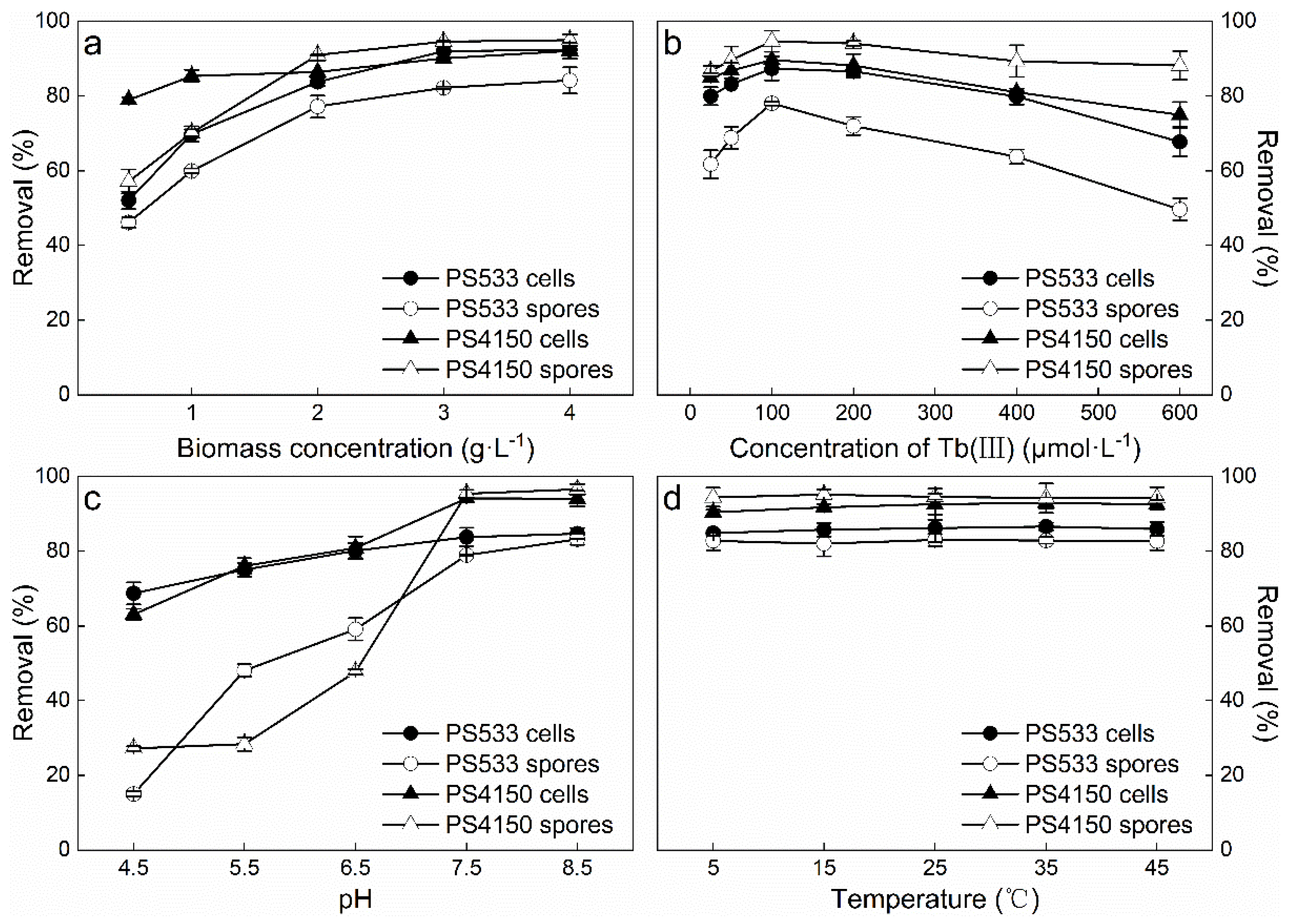
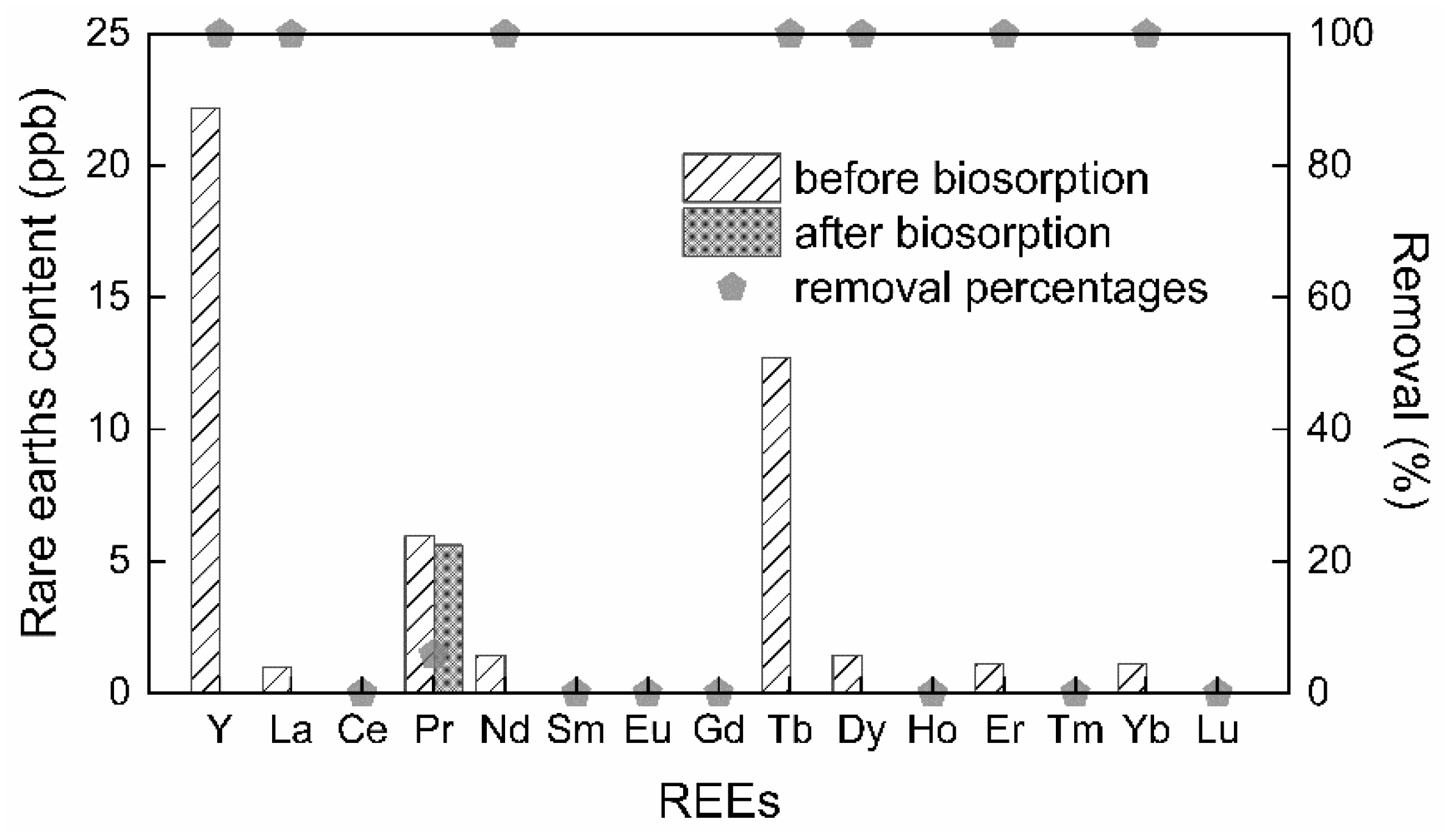


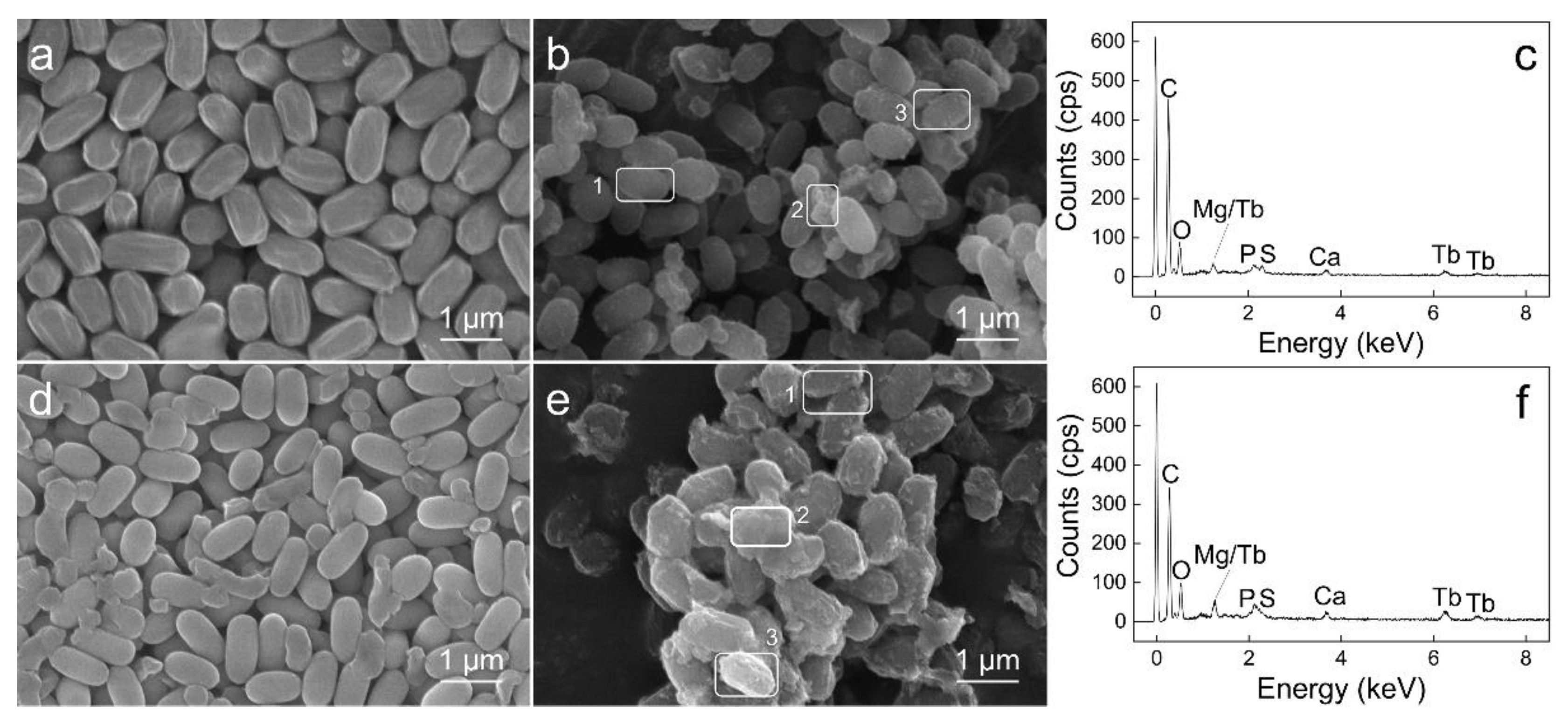
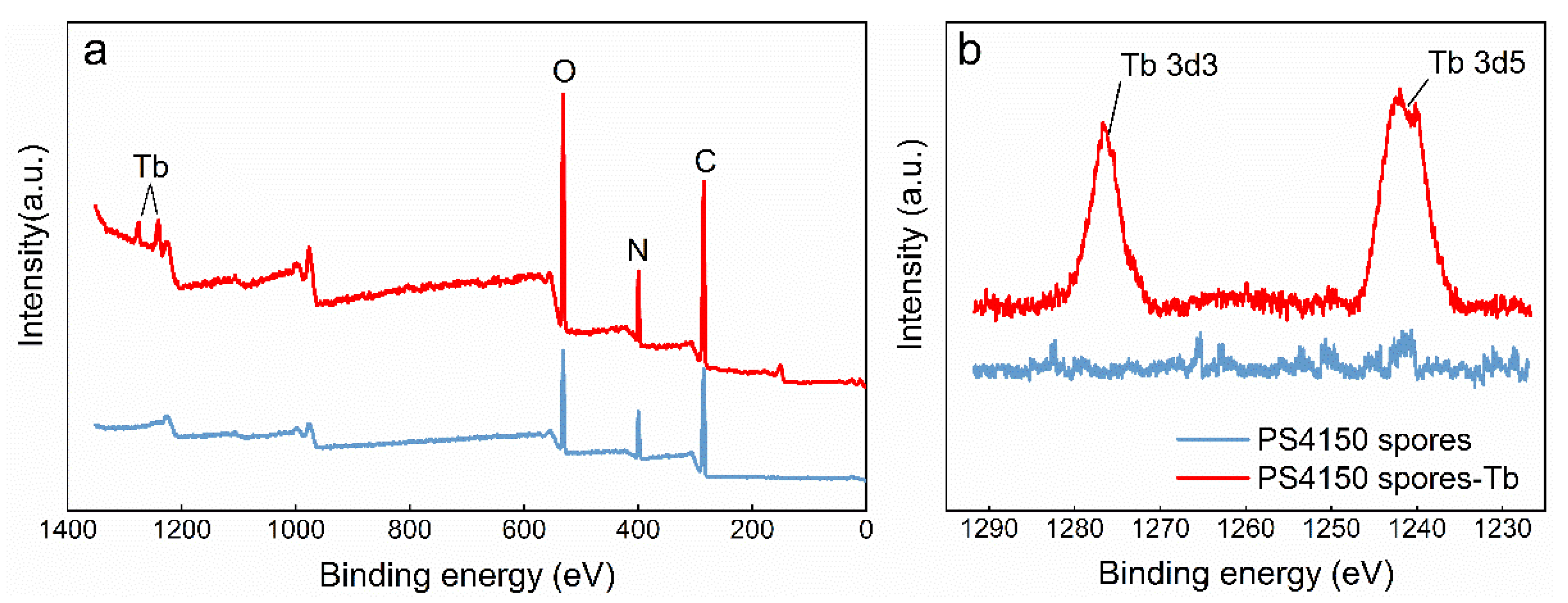
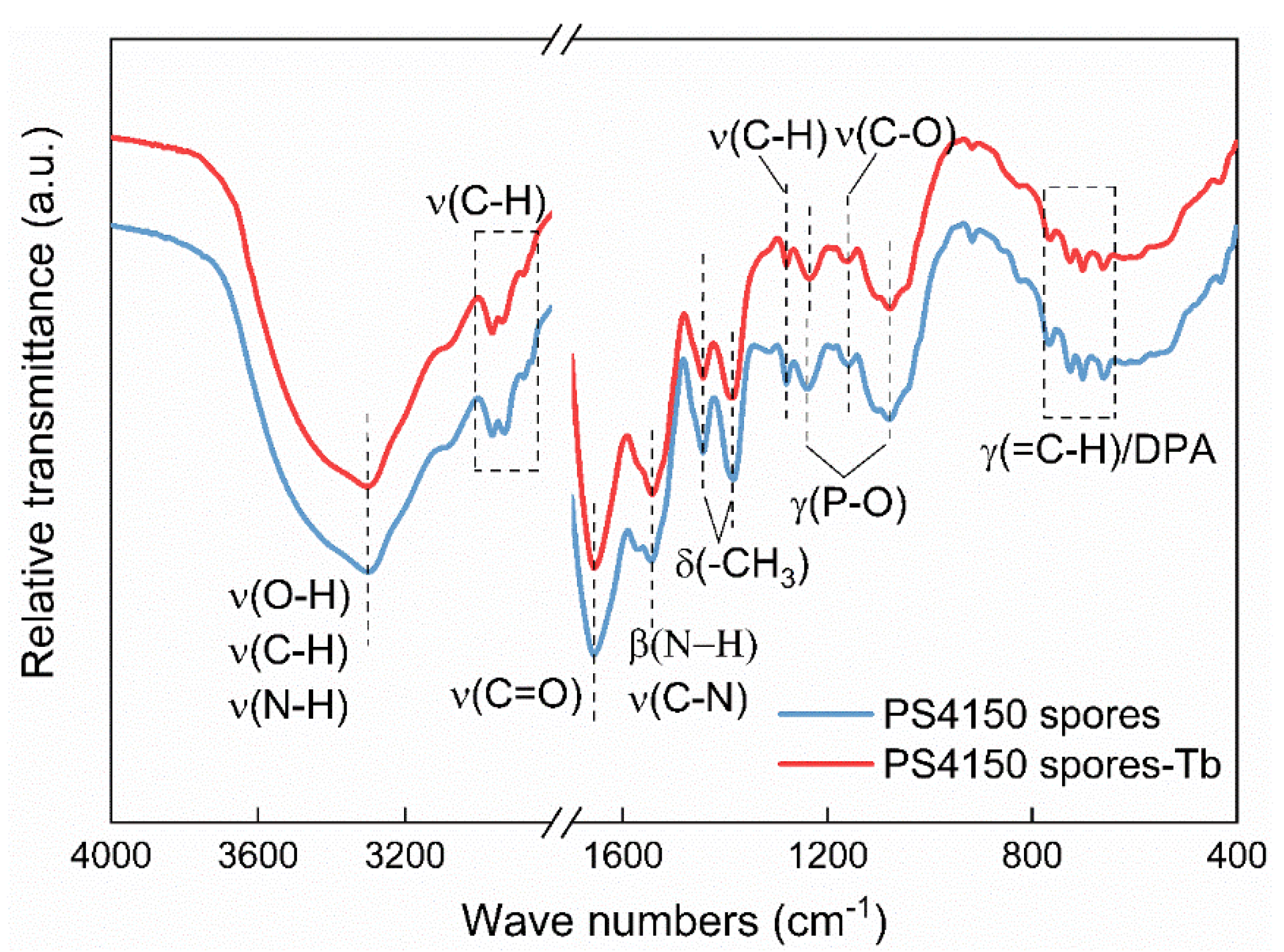
| Different Biosorbents | Amount Adsorbed/ (µmol·g−1) † | Pseudo–First–Order Kinetic | Pseudo–Second–Order Kinetic | ||||
|---|---|---|---|---|---|---|---|
| K1 | qe/(µmol·g−1) | R2 | K2 | qe/(µmol·g−1) | R2 | ||
| PS533 cells | 83.865 | −0.149 | 5.956 | 0.510 | 0.081 | 84.962 | 0.999 |
| PS533 spores | 79.790 | −0.015 | 2.930 | −0.050 | 0.054 | 76.220 | 0.999 |
| PS4150 cells | 92.326 | −0.015 | 1.171 | −0.070 | 0.286 | 91.158 | 0.999 |
| PS4150 spores | 94.792 | −0.162 | 7.162 | 0.422 | 0.041 | 96.246 | 0.999 |
| Different Biosorbents | Langmuir Isotherm | Freundlich Isotherm | ||||
|---|---|---|---|---|---|---|
| qmax (µmol·g−1) | KL | R2 | 1/n | KF | R2 | |
| PS533 cells | 857.140 | 0.001 | 0.995 | 0.460 | 19.145 | 0.939 |
| PS533 spores | 495.850 | 0.002 | 0.993 | 0.395 | 20.213 | 0.909 |
| PS4150 cells | 1 171.200 | 0.001 | 0.991 | 0.507 | 16.763 | 0.944 |
| PS4150 spores | 1 557.208 | 0.001 | 0.990 | 0.542 | 15.913 | 0.950 |
| Different Biosorbents | Elemental Mass Percentage (%) | |||||||
|---|---|---|---|---|---|---|---|---|
| C | O | Mg | P | S | Ca | Mn | Tb | |
| PS533 spores | 74.35 | 20.24 | 0.22 | 1.18 | 1.07 | 2.84 | 0.10 | 0.00 |
| PS533 spores-Tb | 74.93 | 23.25 | 0.26 | 0.09 | 0.18 | 0.48 | 0.00 | 0.81 |
| PS4150 spores | 73.27 | 21.00 | 0.41 | 0.93 | 1.05 | 3.13 | 0.21 | 0.00 |
| PS4150 spores-Tb | 72.01 | 24.94 | 0.59 | 0.09 | 0.19 | 0.80 | 0.00 | 1.38 |
Publisher’s Note: MDPI stays neutral with regard to jurisdictional claims in published maps and institutional affiliations. |
© 2022 by the authors. Licensee MDPI, Basel, Switzerland. This article is an open access article distributed under the terms and conditions of the Creative Commons Attribution (CC BY) license (https://creativecommons.org/licenses/by/4.0/).
Share and Cite
Dong, W.; Wang, H.; Ning, Z.; Hu, K.; Luo, X. Bioadsorption of Terbium(III) by Spores of Bacillus subtilis. Minerals 2022, 12, 866. https://doi.org/10.3390/min12070866
Dong W, Wang H, Ning Z, Hu K, Luo X. Bioadsorption of Terbium(III) by Spores of Bacillus subtilis. Minerals. 2022; 12(7):866. https://doi.org/10.3390/min12070866
Chicago/Turabian StyleDong, Wei, Huimin Wang, Zhoushen Ning, Kaijian Hu, and Xianping Luo. 2022. "Bioadsorption of Terbium(III) by Spores of Bacillus subtilis" Minerals 12, no. 7: 866. https://doi.org/10.3390/min12070866
APA StyleDong, W., Wang, H., Ning, Z., Hu, K., & Luo, X. (2022). Bioadsorption of Terbium(III) by Spores of Bacillus subtilis. Minerals, 12(7), 866. https://doi.org/10.3390/min12070866







